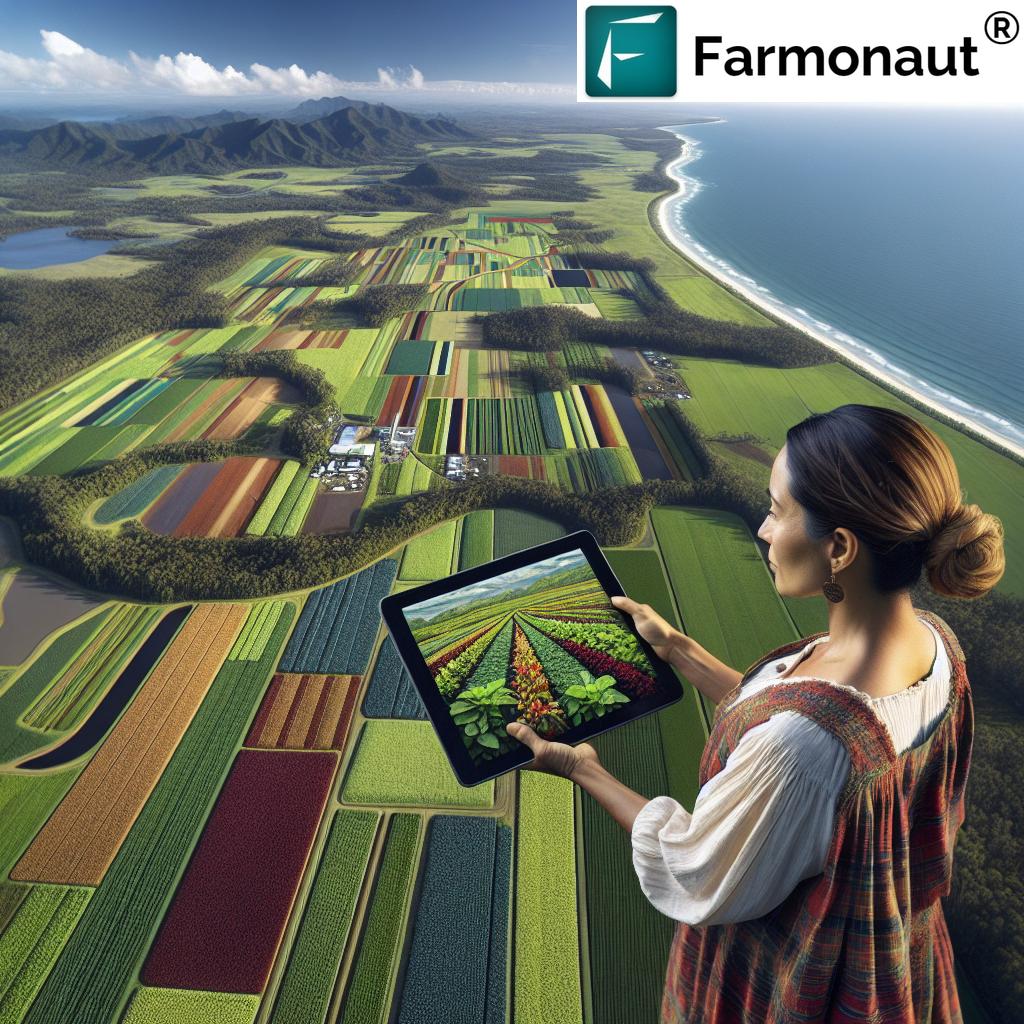Revolutionizing Australian Agriculture: How Precision Farming and AgTech Innovations Drive Sustainable Crop Management
“Australian farmers using precision farming techniques can reduce water usage by up to 30% while maintaining crop yields.”
Welcome to the future of farming in Australia! We’re excited to explore how cutting-edge agricultural technology (AgTech) and precision farming are transforming the landscape of sustainable agriculture across our vast and diverse continent. From the sprawling broadacre farms of the outback to the lush vineyards of our wine regions, innovative technologies are reshaping how we grow crops, manage livestock, and conserve our precious natural resources.
In this comprehensive guide, we’ll delve into the world of smart farming techniques, agricultural drone applications, and advanced crop management solutions that are revolutionizing the way Australian farmers operate. We’ll explore how companies like Farmonaut are at the forefront of this agricultural revolution, providing farmers with powerful tools to enhance productivity, sustainability, and profitability.
The Rise of Precision Farming in Australia
Precision farming, also known as precision agriculture, is a management strategy that uses detailed, site-specific information to precisely manage production inputs. In Australia, this approach has gained significant traction, particularly in broadacre cropping, horticulture, and viticulture sectors.
- Satellite-Based Crop Monitoring: Companies like Farmonaut use advanced satellite imagery to provide real-time insights into crop health, enabling farmers to make data-driven decisions.
- Variable Rate Technology (VRT): This allows farmers to apply different amounts of inputs like fertilizers and pesticides to specific areas of a field, optimizing resource use.
- GPS-Guided Machinery: Tractors and harvesters equipped with GPS technology can operate with centimeter-level accuracy, reducing overlap and improving efficiency.
These precision farming technologies are not just improving productivity; they’re also playing a crucial role in promoting sustainable agriculture practices across Australia.

AgTech Innovations Transforming Australian Farms
The Australian agricultural sector is embracing a wide range of AgTech innovations that are driving efficiency and sustainability. Let’s explore some of the key technologies making waves:
1. Agricultural Drone Applications
Drones have become an indispensable tool for modern farmers, offering a bird’s-eye view of crops and providing valuable data for decision-making.
- Crop Scouting: Drones equipped with multispectral cameras can detect early signs of pest infestations or nutrient deficiencies.
- Precision Spraying: Some advanced drones can apply pesticides or fertilizers with pinpoint accuracy, reducing chemical use and environmental impact.
- Livestock Monitoring: In the vast Australian rangelands, drones help farmers track and manage their herds more efficiently.
2. Soil Health Monitoring Systems
Maintaining soil health is crucial for sustainable agriculture. Advanced monitoring systems are helping farmers understand and improve their soil conditions:
- IoT Sensors: Buried sensors measure soil moisture, temperature, and nutrient levels in real-time.
- Spectral Analysis: Handheld devices can analyze soil composition on the spot, helping farmers make immediate decisions about fertilization.
- Microbiome Mapping: Advanced techniques are being developed to understand and enhance the soil microbiome, crucial for plant health.
3. Climate-Smart Agriculture Technologies
With Australia’s challenging and variable climate, adopting climate-smart technologies is more important than ever:
- Weather Stations: On-farm weather stations provide hyperlocal forecasts, helping farmers plan activities and manage risks.
- Crop Modeling Software: These tools use climate data to predict crop yields and optimize planting schedules.
- Drought-Resistant Crop Varieties: Genomics and biotechnology are developing crops that can thrive in Australia’s often harsh conditions.
Farmonaut: Pioneering Precision Farming Technology in Australia
At the forefront of this agricultural revolution is Farmonaut, a company dedicated to making precision agriculture accessible and affordable for farmers across Australia. Farmonaut’s platform integrates satellite imagery, artificial intelligence, and machine learning to provide farmers with powerful insights and tools.
Key Features of Farmonaut’s Platform:
- Real-Time Crop Health Monitoring: Using multispectral satellite images, Farmonaut provides up-to-date information on vegetation health (NDVI) and soil moisture levels.
- AI-Powered Advisory System: The Jeevn AI system offers personalized recommendations based on real-time data and expert knowledge.
- Blockchain-Based Traceability: Ensuring transparency and security in agricultural supply chains.
- Resource Management Tools: Help farmers optimize their use of water, fertilizers, and other inputs.
By leveraging these technologies, Australian farmers can make more informed decisions, reduce waste, and improve their overall productivity and sustainability.
Explore Farmonaut’s Solutions:
Sustainable Crop Management in Practice
“Sustainable agriculture practices in Australia have led to a 15% increase in soil organic matter content over the past decade.”
The adoption of precision farming and AgTech innovations is having a significant impact on sustainable crop management across Australia. Let’s look at some specific areas where these technologies are making a difference:
Water Conservation in Agriculture
In a country as dry as Australia, water conservation is paramount. Smart farming techniques are helping farmers use water more efficiently:
- Precision Irrigation: Using soil moisture sensors and weather data to apply water only where and when it’s needed.
- Drip Irrigation Systems: Delivering water directly to plant roots, minimizing evaporation and runoff.
- Water Harvesting: Implementing advanced techniques to capture and store rainwater for use during dry periods.
Optimizing Fertilizer Use
Precision farming allows for more targeted and efficient use of fertilizers, reducing costs and environmental impact:
- Variable Rate Application: Applying fertilizers at varying rates across a field based on soil fertility maps.
- Slow-Release Fertilizers: Using innovative formulations that release nutrients gradually, reducing leaching and runoff.
- Organic Fertilizer Management: Implementing precision techniques in organic farming to optimize the use of compost and manure.
Integrated Pest Management
Smart farming techniques are revolutionizing how Australian farmers manage pests and diseases:
- Early Detection: Using drones and satellite imagery to spot pest infestations before they spread.
- Targeted Treatment: Applying pesticides only where needed, reducing overall chemical use.
- Biological Control: Leveraging natural predators and beneficial insects as part of a holistic pest management strategy.

The Role of Data Analytics in Farm Management
Farm data analytics is becoming increasingly crucial in modern agriculture. Platforms like Farmonaut are helping Australian farmers harness the power of data to make better decisions:
- Yield Prediction: Using historical data and machine learning to forecast crop yields accurately.
- Risk Assessment: Analyzing weather patterns and market trends to help farmers manage risks effectively.
- Resource Optimization: Using data to fine-tune the use of inputs like water, fertilizers, and labor.
By leveraging these analytics tools, farmers can not only improve their productivity but also enhance their environmental stewardship.
The Future of Australian Agriculture: Trends and Innovations
As we look to the future, several emerging trends and innovations are set to shape Australian agriculture:
1. Artificial Intelligence in Agriculture
AI is poised to revolutionize farming in Australia, offering unprecedented levels of automation and decision support:
- Autonomous Farming Equipment: Self-driving tractors and harvesters that can operate 24/7.
- AI-Powered Crop Management: Systems that can detect plant diseases and nutrient deficiencies with incredible accuracy.
- Predictive Analytics: Advanced AI models that can forecast weather patterns, market trends, and crop yields with increasing precision.
2. Vertical Farming and Urban Agriculture
As urbanization continues, new forms of agriculture are emerging to meet the demand for fresh, locally-grown produce:
- Vertical Farms: Multi-story indoor farming facilities that can produce high yields in small urban spaces.
- Rooftop Gardens: Utilizing urban rooftops to grow fruits and vegetables, improving food security in cities.
- Hydroponics and Aeroponics: Soilless growing systems that can produce crops with minimal water and space requirements.
3. Blockchain in Agriculture
Blockchain technology is set to transform agricultural supply chains:
- Traceability: Allowing consumers to track the journey of their food from farm to table.
- Smart Contracts: Streamlining transactions between farmers, suppliers, and buyers.
- Carbon Credits: Facilitating the trading of carbon credits for sustainable farming practices.
4. Genomics and Biotechnology
Advancements in genomics are opening new possibilities for crop and livestock improvement:
- CRISPR Gene Editing: Developing crops with enhanced traits such as drought resistance or increased nutritional value.
- Precision Breeding: Using genetic information to accelerate traditional breeding programs.
- Microbiome Engineering: Enhancing soil and plant health through targeted manipulation of microbial communities.
Challenges and Opportunities in Australian AgTech Adoption
While the potential of AgTech is enormous, its adoption in Australia faces some challenges:
Challenges:
- Digital Literacy: Ensuring farmers have the skills to effectively use new technologies.
- Connectivity: Improving internet access in rural and remote areas.
- Initial Costs: Helping farmers manage the upfront investment required for some AgTech solutions.
- Data Privacy: Addressing concerns about the collection and use of farm data.
Opportunities:
- Government Support: Increasing funding and incentives for AgTech adoption.
- Education and Training: Developing programs to upskill farmers in digital technologies.
- Collaborative Research: Fostering partnerships between universities, agribusinesses, and technology companies.
- Export Potential: Leveraging Australia’s AgTech expertise to become a global leader in agricultural innovation.
By addressing these challenges and seizing the opportunities, Australia can position itself at the forefront of global agricultural innovation.
Australian AgTech Adoption and Benefits
| AgTech Innovation | Adoption Rate in Australian Agriculture | Primary Agricultural Sector | Key Benefits | Sustainability Impact (1-5) |
|---|---|---|---|---|
| Precision Farming | 65% | Broadacre Cropping | Increased Yield, Reduced Input Costs | 5 |
| Agricultural Drones | 40% | Horticulture | Improved Crop Monitoring, Targeted Spraying | 4 |
| Soil Health Monitoring | 55% | Viticulture | Optimized Fertilizer Use, Better Soil Management | 5 |
| Variable Rate Technology | 50% | Broadacre Cropping | Reduced Chemical Use, Improved Resource Efficiency | 4 |
| GPS-Guided Machinery | 75% | Broadacre Cropping | Increased Efficiency, Reduced Fuel Consumption | 3 |
Conclusion: Embracing a Sustainable Agricultural Future
The integration of precision farming and AgTech innovations is transforming Australian agriculture, driving sustainable crop management practices across the country. From the use of satellite imagery and AI-powered analytics to the adoption of climate-smart technologies, farmers are equipped with powerful tools to enhance productivity, conserve resources, and reduce environmental impact.
Companies like Farmonaut are playing a crucial role in this transformation, providing accessible and affordable precision farming solutions that empower farmers of all sizes. As we look to the future, the continued development and adoption of these technologies will be key to ensuring the sustainability and prosperity of Australian agriculture in the face of climate change and growing global food demand.
By embracing these innovations and addressing the challenges of implementation, Australian farmers can lead the way in sustainable agriculture, setting a global standard for efficient, productive, and environmentally responsible farming practices.
FAQ: Precision Farming and AgTech in Australian Agriculture
Q: What is precision farming, and how is it benefiting Australian farmers?
A: Precision farming uses technology to optimize crop management, allowing farmers to apply inputs like water and fertilizer more efficiently. In Australia, it’s helping farmers reduce costs, increase yields, and minimize environmental impact.
Q: How are drones being used in Australian agriculture?
A: Drones are used for crop scouting, precision spraying, and livestock monitoring. They provide farmers with aerial imagery and data that help in early detection of issues and more efficient farm management.
Q: What role does artificial intelligence play in modern farming?
A: AI is used in various aspects of farming, from predictive analytics for crop yields to autonomous farming equipment. It helps farmers make data-driven decisions and automate complex tasks.
Q: How is AgTech helping with water conservation in Australian agriculture?
A: AgTech solutions like precision irrigation systems, soil moisture sensors, and weather forecasting tools help farmers use water more efficiently, which is crucial in Australia’s often dry climate.
Q: What are the main challenges in adopting AgTech for Australian farmers?
A: Key challenges include digital literacy, internet connectivity in rural areas, initial investment costs, and data privacy concerns. However, government support and education initiatives are helping to address these issues.
Explore More:
- API Access: For developers interested in integrating Farmonaut’s satellite and weather data into their own systems, check out our API and API Developer Docs.




















